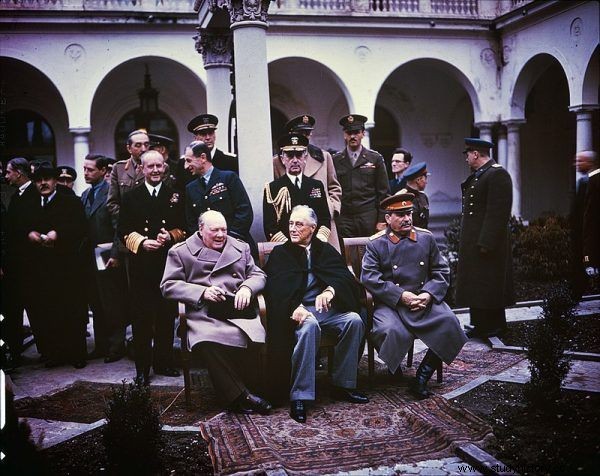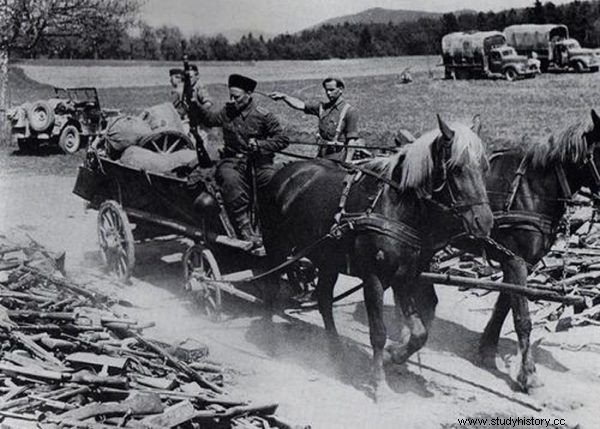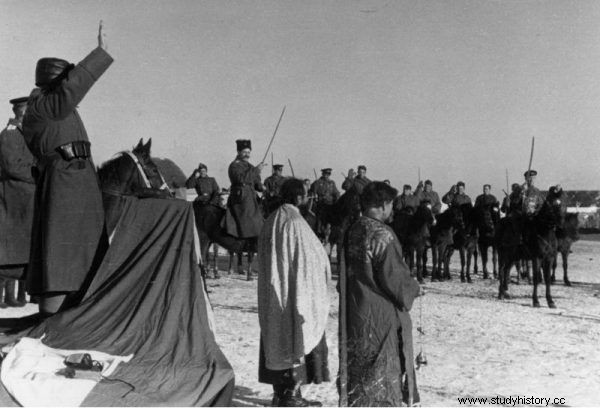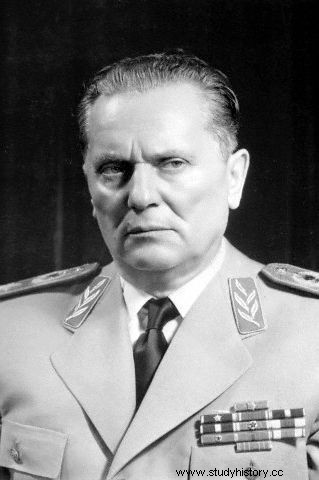During the conference of the three powers in Yalta, Stalin received an assurance that the citizens of the Soviet Union, who found themselves in Western Europe as a result of the war, would return to their beloved communist homeland - even if they did not want to. The result of the Yalta agreements were, inter alia, the tragic events in Lienz, Austria, where the British handed over tens of thousands of Cossacks to the Russians. The NKVD killed many of the men handed over at once, several hundred meters across the border river. The English must have heard the shots…
In Poland, it is believed that during the Second World War we were betrayed at least several times by our allies. It started as early as September 1939, when France and Great Britain declared war on Germany, but did not attack them in the west, as they had previously pledged to do. Later cases of "betrayal" against Poland happened many times. The absence of Poles at the "Victory Parade" in London was a sad summary of the cynical attitudes of the Western allies. Even the pilots of the Polish 302 and 303 fighter squadrons, who a few years ago devoutly defended England against Luftwaffe attacks, did not appear there.

Conference in Yalta
Unfortunately, it is no consolation that not only Poles were betrayed and "exposed to devour" during this war. The fate of the war was cruel to many other nations, such as the Chechens and Ingush, whom Stalin expelled as punishment to Kazakhstan. However, the fate of the Cossacks was especially tragic and - in order to gain independence - decided to cooperate with the Germans. For this they were cruelly punished by Stalin, with the considerable cooperation of the British, who - in accordance with the order - handed over the Cossacks to the NKVD and in many cases sentenced them to death. Of course, the English had assured the Cossacks earlier that they would never hand them over to the Soviets.
Stalin wants his back
These tragic events took place at the turn of May and June 1945 in Lienz, Austria, on the Drava River. The dramas that took place there were the result of a secret Soviet-British-American agreement that was concluded during the conference of the three powers in Yalta. It assumed that all USSR citizens who would find themselves in the Western zone of occupation after the end of hostilities, would be sent back to their "homeland".
It was supposed to apply to all Soviet citizens, no matter for what reason they ended up in the west. These records stipulated that "[...] all persons should be surrendered to the Soviet Union, also against their will, and if necessary - by force who on September 1, 1939 were citizens of the Soviet Union or on June 22, 1941, were soldiers of the Red Army and were taken prisoner. in German uniforms or as voluntary allies of the Germans. ”
Stalin placed particular emphasis on the return to his homeland of Soviet prisoners of war who had been captured by the Germans. The fate of the Russians in captivity was tragic. The Germans treated them cruelly, starved them, forced them to hard physical labor and murdered them. For this reason - just wanting to survive - many of them decided to join the collaborative units, fighting together with the Germans against the Soviets. It was from these people that the soldiers of the ROA and RONA (Russian Liberation Army) units led by Andrei Vlasov were recruited.

Cossacks lay down their arms against the British
Stalin intended to punish them not only for fighting against Soviet Russia, but also for allowing them to be captured at all. In accordance with his orders, tens of thousands of Soviet soldiers "liberated" from POW camps were sent to "rehabilitation" camps for the next few years where they had to atone for their guilt. Soldiers from Soviet territories who decided to fight against the USSR faced an even worse fate. Usually, after being captured, they were not even sent to camps, but were shot immediately. In exceptional cases, they were brought to trial, and so, for example, Andrei Vlasov was convicted and hanged "only" in August 1946.
Stalin knew that the thousands of USSR citizens who had been relocated to the west as a result of the hostilities would not want to return to the bosom of "Matushka Russia" after the war. Therefore, in Yalta, he guaranteed their "return".
Operation "Keelhaul"
In historiography, the events related to the implementation of the assumptions of the secret Yalta agreement are referred to as Operation Keelhaul, or keel-pulling. For hundreds of years, dragging was one of the cruelest forms of punishing sailors who committed wrongdoing on a ship. The victim was tied with ropes by the arms and legs and dragged under the bottom and keel of the sailing ship. Such a punishment was rarely survived, but there were those who miraculously survived the torture, but emerged half-drowned, with flaps torn from their bodies. The code name chosen by the English for the surrender of Soviet citizens was unfortunately very accurate ...
The real course of the post-Yalta Operation Keelhaul was secret until the 1970s, when, thanks to the work of several British and Cossack historians, it was revealed. As with the Katyn Massacre, the countries that won the Second World War knew exactly what had happened, but - in the common interest - kept the matter secret. So the British and Americans kept their mouths shut, but also - oddly enough - the Soviets. Maybe because they knew the exact fate of the tens of thousands of Cossacks that the British gave them?
How did the Cossacks deserve such a punishment? Mainly lack of humility ... for they had fought with Russia for centuries and did not succumb to Moscow's domination. Even after the birth of the Soviet state, they resisted it for a long time. The territories inhabited by the Cossacks were not completely controlled by the Soviet security services, and the Cossacks lived there as before, cultivating their traditions and not recognizing the sovereignty of the Kremlin.
Cossacks allies of the Third Reich
However, the Soviet boot pressed more and more rebellious nations, so the Cossacks looked to the west with hope. The attack of Germany on the USSR in June 1941 was for them, as well as for many other nations of the USSR, a chance to regain independence. Ukrainians, but also Chechens, Ingush and Cossacks tried to create their own separate state. Without waiting for the arrival of the Germans, they began to create combat units, in accordance with tradition - riding horses, fighting against the Red Army.
At first, the Cossacks fought without anyone's help, but later they were granted it by the Wehrmacht, which - in the vast expanses of Soviet Russia - constantly lacked soldiers. In the vast steppes, swift Cossack cavalry units secured the railroads and fought the guerrillas. When they proved successful in frontline combat, Hitler himself accepted the creation of Cossack units. The Fuhrer decided that the Cossacks - by fighting with Russia for centuries - proved that they were not Slavs, and that they were a better nation than others living in the eastern borderlands of Europe.

Cossack troops were incorporated into the Wehrmacht
With Hitler's consent, in 1943, the formation of a large, regular Cossack unit began in occupied Poland. Initially, 15,000 soldiers, mainly former Soviet prisoners of war, who decided to "change the front" were conscripted into it. In many cases the prisoners were extremely exhausted and starved, and joining the army was the only chance to stay healthy and alive. In this way, the prisoners became soldiers of the Cossack collaborative units.
First, the 1st Cossack Cavalry Division was formed, and later - a much larger unit - the 15th SS Cossack Cavalry Corps. There were also other, less numerous units, which, together with their accompanying civilians, numbered at least 50,000 people. It must be remembered that, according to tradition, Cossack units went to the front and returned from it on horses, with numerous camps where the wives and children of soldiers lived, as well as old men who could no longer hold themselves in the saddle, but still able to pull the trigger of a rifle. The diversity of these units is evidenced by the fact that they included Don, Tera, Kuban, Siberian, Zabaikal and even Ussuri Cossacks. Each of these groups had different customs, and in the case of the military - uniforms (including fur caps, the so-called papachas) and weapons.
The Cossacks are fighting Tito
After all, the Cossack units were not full-fledged combat units, so they were sent not to the front but to the rear, to Yugoslavia, where they fought against the Tito partisans. Several Cossack units (including the 4th Battalion of the 75th Cossack Regiment, 69th and 572nd Cossack Battalions) took part in the suppression of the Warsaw Uprising, during which they committed war crimes against both the civilian population of Warsaw and soldiers insurgents.
The Cossacks were convinced that the fight against the guerrillas is also a fight against communism. However, despite the relative successes in combat, the nationwide Cossack case looked losing, because the Red Army was quickly regaining territory in Eastern Europe, occupying Yugoslavia, and everything indicated that it would soon settle the war in its favor.
In this situation, the Cossack commanders decided that they should make their way westward, in order not to fall into the hands of the Soviets under any circumstances. As former Soviet citizens, they knew perfectly well what this meant. Retreating from Yugoslavia and Italy, they crossed the mountain areas and found themselves in the territories of Austria, occupied, among others, by by the British 11th Panzer Division to which they surrendered. The Cossack grouping with civilians that reached Lienz numbered about 50,000. people. The officers and their families were quartered in the barracks, the rest were camping out in the open. The camp was over 20 kilometers along the river, and cows, Cossack horses, and even camels also arrived with the camps! There were also less numerous Caucasian troops led by Sultan Giray-Kłycz.

The Cossacks were also used to fight the Tito guerilla
The Cossack soldiers had to surrender all their weapons, but the British allowed them to keep their pistols and melee weapons, ensuring that they respected the Cossack tradition. Successive Cossack refugees kept reaching the camp on the border of the Drava River, who made their way through various routes, believing that such a large group of troops and civilians would receive security guarantees. The Cossacks believed uncritically the British officers who guaranteed their safety and vowed not to be handed over to the Soviets. They were even deluded by the promise of another war, this time against the USSR, in which the Cossacks were to take part on the west side. However, their fate was long overdue…
Disarm and spend!
The English handed out oranges and chocolate to Cossack children, and to soldiers handed out cigarettes and full British food rations. It was even allowed to build several field churches. On May 28, the British invited Cossack ataman officers to a conference in the town of Spittal. There, almost 1.5 thousand. the people were disarmed and, with the help of truncheons and rifles, they were pushed into trucks that were sent to the Soviet side. This group included, inter alia, 35 generals, 167 colonels and 283 lieutenant colonels. In this way, the English wanted to deprive the people of their commanders and leaders gathered by the river. I must admit that this plan was carried out perfectly. In the following days, the British carried out an operation to hand over the remaining Cossacks to the Soviet side.
Tanks rolled up and the Cossack camp was surrounded on three sides by armed soldiers who forcibly drove terrified people to trucks and railroad cars with barred windows. From the side of the river there were no soldiers, because the Drwa was impenetrable in this place, it flowed between high rocks, it was deep and rushing. Some of the Cossacks tried to break through the cordon, many - including families with children - chose to escape and jump from the rocks into the river. There were dramatic scenes in the camp, families being separated, men jumping from the bridge into the river, cutting their veins with glass or begging the English to be stabbed with a bayonet. There were also cases of infanticide. Few Cossacks managed to escape to the mountains.
In addition to the men sent back earlier, on June 1, the British handed over to the Soviets 4,000 more. women and 2,500 Cossack children. Trains passed quickly to the other side of the border where pre-selection was carried out. Men and women were sent by train to labor camps deep into the USSR, and children were taken to orphanages. The last officers were also recovered from the crowd and shot by the SMERSZ units. By the end of June, about 50,000 people had been handed over to the Soviets. In several other places on the border, smaller groups of captured Cossacks were handed over.
